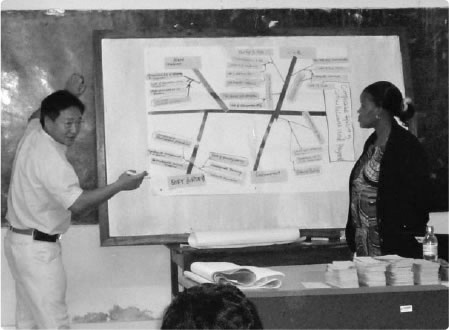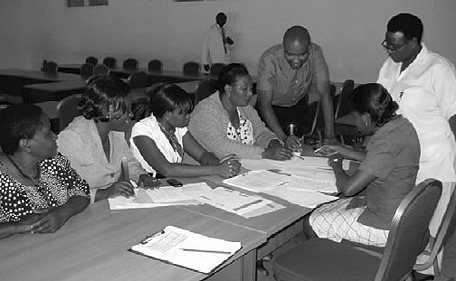Japan's Official Development Assistance White Paper 2011
Column 9
Total Quality Management for Better Hospital Services
—Promoting the 5S Approach in Tanzania—

Mr. Ishijima (left) giving a lecture on Kaizen at Mbeya Referral Hospital (Photo: Hisahiro Ishijima)
Tanzania suffers from a serious shortage of human resources in the field of healthcare(*1). As of September 2010, public medical institutions had only about 40% of the personnel they needed, and more than 20,000 specialist posts remained unfilled. A lack of resources overall, as represented by that of personnel, is said to be the source of the nonexistent improvement in quality of services provided by healthcare facilities.
Japan offers cooperation in an aim to break through this situation and improve the quality of healthcare services. One is the Clean Hospital Program carried out since 2007 in 15 African countries. The program installs and spreads in healthcare facilities the Japanese quality control approach of 5S (Sort, Set, Shine, Standardize, and Sustain) and Kaizen (Continuous Quality Improvement)(*2). It continues to this day with efforts by each country. The initiative in Tanzania, revolving around JICA expert Hisahiro Ishijima, is producing remarkable results.
When the Clean Hospital Program launched in 2007, the first to raise his hand and join it was Dr. E.R. Samky, Director General of Mbeya Referral Hospital. He had become fascinated with the improvements 5S brought to the quality of healthcare after participating in a JICA seminar in Japan and visiting a hospital in Sri Lanka that, despite great constraints in a shortage of resources, adopted the Japanese 5S and succeeded in dramatically improving its service quality. Dr. Samky declared he would make Mbeya Referral a regional hub of 5S in Africa, and in a month's time took his experiences in training back home and started activities in his hospital.
Mbeya Referral is a key national hospital in southern Tanzania that serves as many as 190,000 outpatients a year. But until then, it had problems in the management of medical devices and drugs. The efficiency of its operations was also bad, and there was no end to the number of patients who waited all day and still could not receive treatment.
Having declared the adoption of the 5S, Dr. Samky formed a quality improvement team comprising staff members who were as motivated as he was. He set up operation improvement teams in every ward of the hospital, and set out to commence activities. Yet it was no easy task to get the 5S activities to take root. The purpose of the activities is to form a habit of always keeping one's own work environment in order, and through it, to build the foundation for identifying and resolving problems. The whole point is for the staff to take the initiative. Whereas at the outset, some put up resistance. A number of staff members flat out refused to cooperate, questioning why they specialists had to take part in a cleaning campaign. The quality improvement team persisted with their efforts slowly and patiently. In time, the results of maintaining order and eliminating waste became obvious: they actually helped to improve stock management and reduce costs. This gained the understanding and sympathy of all staff members, and three years later, in 2010, Mbeya Referral ranked number one in the national hospital audit.
The outcome has spread throughout the country, and as of 2011, 46 hospitals in Tanzania carry out 5S activities. Even the Tanzanian government has incorporated the activities into its public health policies and strategies. And Mbeya Referral, as a model of success, now welcomes inspecting visitors from neighboring countries to which the 5S activities has spread.
Supporting the expansion and spread of the activities on site at the hospitals in each area are Japan Overseas Cooperation Volunteers (JOCV). They had worried about the limit to the scope of their activities—after all, they could not provide medical treatment—but thanks to Mr. Ishijima's introducing the 5S scheme, they are now carrying out spontaneous 5S activities at each of their posts, sharing information between their hospitals, joining Mr. Ishijima in the regular training sessions implemented by the Tanzanian Ministry of Health and Social Welfare, and working enthusiastically to bolster the activities. Mr. Ishijima, in turn, supports their activities. And since 2010, JICA has even started dispatching volunteers especially for 5S.
And so the 5S activities are expanding smoothly. Yet Mr. Ishijima is not completely satisfied. Smiling, he says: "Our activities have just begun. Our goal is to spread them to all hospitals in Tanzania."
(*1) The World Health Report 2006 (World Health Organization) counts Tanzania as one of 57 countries with a critical shortage of health service providers.
(*2) The 5S–Kaizen approach forms a habit of the 5S principles to improve the work environment so as to provide high-quality health services, and practices the Kaizen problem-solving process based on worker participation to improve work content and services using what limited resources are available.

Staff training by an operation improvement team at Mbeya Referral Hospital (Photo: Hisahiro Ishijima)
